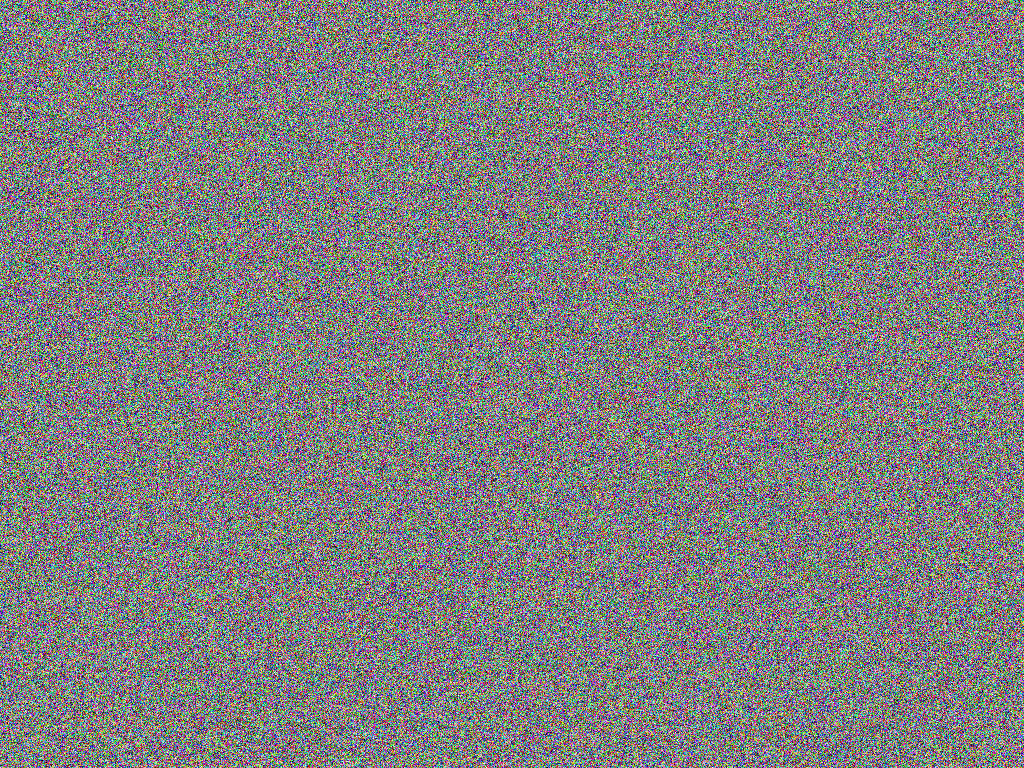1024x768
every imaginable and unthinkable image can materialize every second

"If someone invented a machine which produced paintings like Raphael, would these paintings still be beautiful?" "No, they wouldn't."
"What about the machine though? As it became an everyday appliance, wouldn't it be more beautiful than the paintings?"
Denis Diderot, Vernet. The Salon of 1767
Johannes Franzen – 1024 x 768
In the history of art, there have always been attempts to "liberate" works of art from their creators. With his Series 1024 x 768, Johannes Franzen follows on such experiments by the Dadaists and surrealists, and maybe even more so artists like John Cage. In pieces such as Cage's well-known 4'33--where every showing turns into an unforeseeable, unrepeatable event--, the unresolved, unrestrained, and the arbitrary become dominant forces. Franzen's machine transposes colored noise into pictures; it turns no longer palpable complexities into a visual experience.
Each digital picture consists of a number of individual square dots. In the commonly used format . . . this means 1024 in width times 768 in heigth. And each of these dots is defined by one of 16.7 million possible colors. Franzen utilizes a technique that has become central in today's experience of the world, applying the parameters of picture production on a computer screen.
If every image that has ever appeared or will ever appear on a screen is composed of a certain number of dots, and if each of these dots is defined by a limited number of colors, the number of possible pictures being displayed is also limited--and calculable. On a 15-inch monitor, that number would amount to about 96 million digits, in other words be inconceivably high.
The "picture-machine" is a computer which, through a software programmed by myself, sets out for the screen. Every five to ten seconds, a new image appears. For every new picture, that is, the computer program assigns a color to each of the 1024 times 768 dots. The machine does not proceed linearly, i. e. attribute a different color to one by one of the dots on display. Rather, a random generator turns out new colors for all the dots with each new calculation; every time, every theoretically possible image can appear.
Now the problem lies less in the machine than in the viewer because, by human standards, the computer takes ages to generate all possible images. Chances are that during a human lifetime, no actual, recognizable picture will ever be composed (besides, one would have to be present when it showed up on the screen). The great majority of these images, in fact, are only abstract, a multi- color combination of dots, where at best one can make out a predominance of certain shades, or a hazy concentration of colors in some spots.
The beauty of the machine lies in its utopian potential. All possible images are contained in it and could, theoretically, appear at any given moment. This might include, for example, all images photographed from a train compartment window during a journey. Or, every page of every text ever written. Or reproductions of all paintings ever painted. Or a combination of all these. Yet still, the number of possible images would always be a definite one.
I exposed some of these pictures on very large format.The exposed data lead to a picture of nothing but small, clearly-defined squares of different colors. It is very easy to see when you are standing right in front of it. But take one or two steps back, and you will get an entirely different picture. The pictures were digitally exposed on Ilfochrome, on a format of 48 by 64 inches (121.92 by 162.56 cm). This format is derived from the dpi-number ("dots per inch") of the monitor, and allows for clear shape and color differentiation between the individual dots, while at the same time re-enacting the effect of these principally distinctive dots disappearing in the picture as a whole (as is usually intended with a digital photograph). Viewed from up-close, the photographs look like multi-colored webs; from afar they turn into atmospherical color compositions.
When the machine does what it does best and assigns colors to dots at random, attaching no sense or purpose whatsoever, it works against the viewer and leaves his or her longing for identifiable pictures unfulfilled. It thus contrasts with most other computer displays that reliably and comfortingly present an easily recognizable world, a world which may seem chaotic at times but generally keeps its rules in place.
However, just because the images do not carry meaning in themselves, a viewer of the 1024 x 768 series is also handed great autonomy. In the individual viewing process, individual atmospheres and moods evolve; images, shapes and color constellations can be discovered and explored ad libitum, while the machine has long shed itself of all complicity.
Dr. Bettina Schmitt
Passages in italics are quoted from Johannes Franzen's Die Bildmaschine.